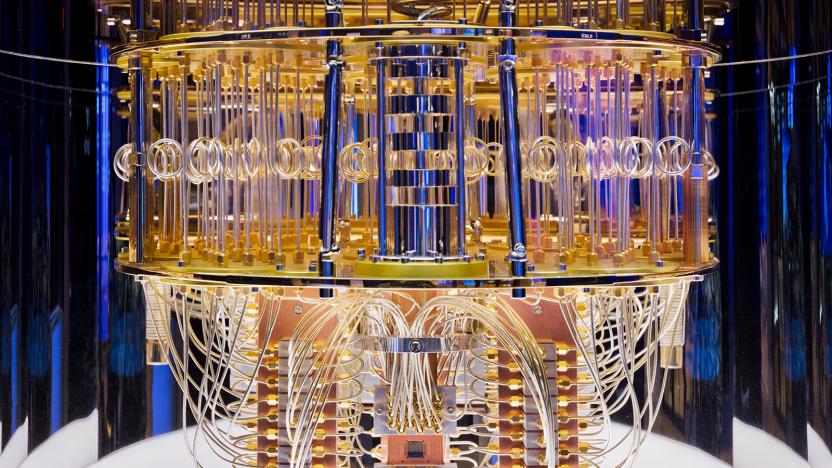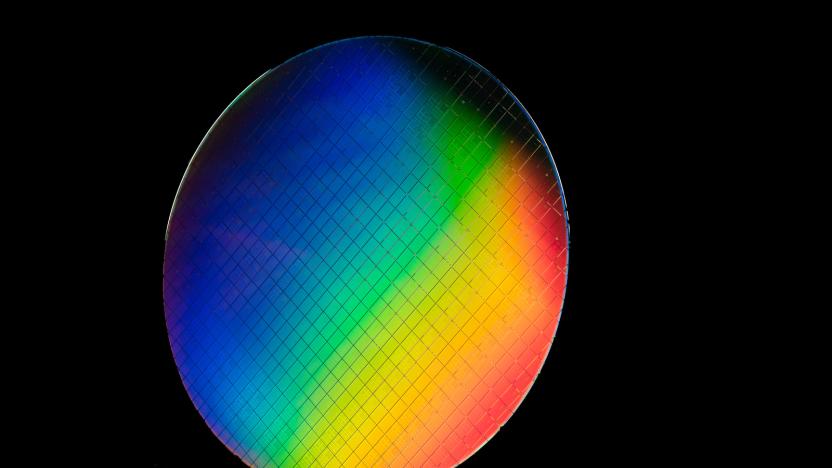quantum physics
Latest

IBM quantum computers now finish some tasks in hours, not months
IBM has found a way to speed up some quantum computing tasks by 100 times, finishing them in hours rather than months.

Intel's 'hot' qubits could lead to more advanced quantum computers
Intel and QuTech have successfully controlled qubits that don't need to be chilled to the very edge of absolute zero.

Scientists unveil image of quantum entanglement for the first time ever
For the first time ever, physicists have captured an image of quantum entanglement. In a paper published in the journal of Scientific Advances, scientists from the University of Glasglow shared the first known image of a Bell entanglement. The photo depicts two photons interacting and sharing physical states for a brief instant -- an event that occurs regardless of the actual distance between the particles.

AI can simulate quantum systems without massive computing power
It's difficult to simulate quantum physics, as the computing demand grows exponentially the more complex the quantum system gets -- even a supercomputer might not be enough. AI might come to the rescue, though. Researchers have developed a computational method that uses neural networks to simulate quantum systems of "considerable" size, no matter what the geometry. To put it relatively simply, the team combines familiar methods of studying quantum systems (such as Monte Carlo random sampling) with a neural network that can simultaneously represent many quantum states.

Alt-week 11.03.12: zombie animals, martian methane and self healing buildings
Alt-week peels back the covers on some of the more curious sci-tech stories from the last seven days. After a week where large numbers of people found themselves at the mercy of mother nature, many will be reminded just how vulnerable we really can be at times. That said, science still provides us with a pretty big stick to whack many other problems with. After the break we look at how crumbling buildings could soon be self-healing, why some UK-based scientists think they are one step closer to answering the "is light made of waves or particles" quandary, and NASA reveals its latest results in the hunt for martian methane. Oh, and there's some zombie animals too. This is alt-week.

Flawed diamonds are perfect ingredients for quantum computing, just add time travel
Ready to suspend your brain cells in a superposition of disbelief? Good, because the latest news published in Nature is that diamonds are a quantum computer's best friend -- particularly if they're flawed. An international team of scientists sought out sub-atomic impurities in a 1mm-thick fragment of over-priced carbon and used these as qubits to perform successful calculations. A "rogue" nitrogen nucleus provided one qubit, while a free electron became a second. Unlike previous attempts at solid-state quantum computing, this new effort used an extra technique to protect the system from decoherence errors: microwave pulses were fired at the electron qubit to "time-reverse" inconsistencies in its spinning motion. Don't fully get it? Us neither. In any case, it probably won't stop jewellers tut-tutting to themselves.

IBM: We're on the cusp of the Quantum Computing revolution (video)
Technology's holy grail is the development of a "perfect" Quantum Computer. Traditional computers recognize information as bits: binary information representing "On" or "Off" states. A quantum computer uses qubits: operating in superposition, a qubit exists in all states simultaneously -- not just "On" or "Off," but every possible state in-between. It would theoretically be able to instantly access every piece of information at the same time, meaning that a 250 qubit computer would contain more data than there are particles in the universe. IBM thinks it's closer than ever to realizing this dream and if you want to know more, we have the full details after the break.

Researchers use lasers to supercool semiconductor membranes, blow your mind
Ah, lasers. Those wonderful, super intense beams of light that we've seen used in headlights, projectors, and naturally, death rays. Like us, researchers at the Niels Bohr Institute at the University of Copenhagen figure there's nothing lasers can't do, and have figured out a way to use them to cool a bit of semiconducting material. This bit of black magic works using a membrane made of gallium arsenide and is based upon principles of quantum physics and optomechanics (the interaction between light and mechanical motion).Turns out, when a one millimeter square membrane of gallium arsenide is placed parallel to a mirror in a vacuum chamber and bombarded with a laser beam, an optical resonator is created between them that oscillates the membrane. As the distance between the gallium arsenide and the mirror changes, so do the membrane's oscillations. And, at a certain frequency, the membrane is cooled to minus 269 degrees Celsius -- despite the fact that the membrane itself is being heated by the laser. So, lasers can both heat things up and cool them down simultaneously, and if that confuses you as much as it does us, feel free to dig into the science behind this paradoxical bit of research at the source below. In other news, left is right, up is down, and Eli Manning is a beloved folk hero to all Bostonians.

First light wave quantum teleportation achieved, opens door to ultra fast data transmission
Mark this day, folks, because the brainiacs have finally made a breakthrough in quantum teleportation: a team of scientists from Australia and Japan have successfully transferred a complex set of quantum data in light form. You see, previously researchers had struggled with slow performance or loss of information, but with full transmission integrity achieved -- as in blocks of qubits being destroyed in one place but instantaneously resurrected in another, without affecting their superpositions -- we're now one huge step closer to secure, high-speed quantum communication. Needless to say, this will also be a big boost for the development of powerful quantum computing, and combine that with a more bedroom friendly version of the above teleporter, we'll eventually have ourselves the best LAN party ever.

Quantum batteries are theoretically awesome, practically non-existent
Today's dose of overly ambitious tech research comes from the physics lab over at the University of Illinois at Urbana-Champaign, in a proposal titled "Digital quantum batteries: Energy and information storage in nano vacuum tube arrays." It's like a who's who of undelivered promises got together and united to form one giant and impossible dream, but it's one we'd prefer to believe in regardless. Aiming to improve battery performance by "orders of magnitude," the project's fundamental premise is that when capacitors -- and we're talking billions of them -- are taken to a small enough scale and packed to within 10nm of one another, quantum effects act to prevent energy loss. The projected result is a wonderful world of rapid recharges and storage of up to ten times the energy current lithium-ion packs can hold, as well as the potential for data retention. The only problem? It would take a year just to build a prototype, meaning we can expect market availability somewhere between a score from now and just prior to the underworld morphing into an ice rink.

Danish scientists achieve advanced quantum teleportation
As you can imagine, here at Engadget, we love it when science fiction becomes more science and less fiction. With that in mind, we're pleased to pass along the news that Danish scientists at Copenhagen University have made a breakthrough in the wacky world of quantum teleportation by transporting quantum information over a distance of half a meter (1.6 feet). In order to achieve this, Dr. Eugene Polzik and his team shined a strong laser beam into a cloud of room-temperature cesium atoms that shared the same directional spin. As Scientific American reports: "The laser became entangled with the collective spin of the cloud, meaning that the quantum states of laser and gas shared the same amplitude but had opposite phases. The goal was to transfer, or teleport, the quantum state of a second light beam onto the cloud." (It should be noted that this process is more akin to duplication than actual teleportation, i.e. using this method on a human being would result in the formation of a doppelganger and not a magical Star Trek-like movement of matter). To achieve this goal, Polzik and other scientists added a second weaker laser pulse and split the two beams into separate branches in order to measure the difference between the quantum phases; through that measurement the scientists were then able to transfer the information of the spin state of the weak laser to the combination of the cesium atoms and the strong laser, without disturbing the quantum entanglement between the laser and the cesium. Umm, so the short of it is: one small step for a cesium atom, but one giant leap for quantum computing research and the advancement of teleportation theory.[Thanks, Josh H. and Eric M.]Read - ReutersRead - Scientific American






